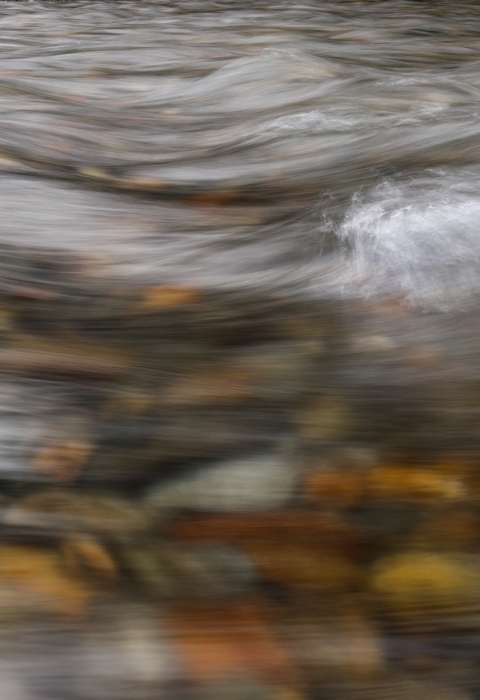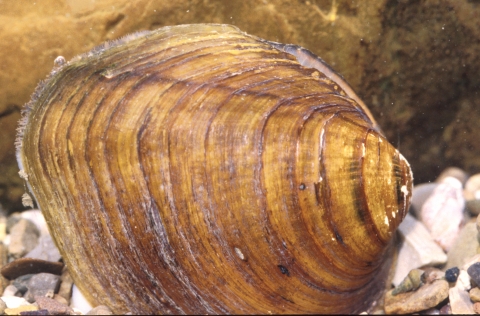Asheville, NC – Following a review of the best available science and public comment, the U.S. Fish and Wildlife Service is listing longsolid and round hickorynut freshwater mussels as threatened under the Endangered Species Act. The Service is also designating critical habitat and tailoring ESA protections to protect these imperiled species from going extinct throughout all or a significant portion of its range in rivers and streams in the eastern United States.
“Endangered species recovery is complex and difficult work and that’s why we are working collaboratively with biologists from state wildlife agencies and other experts to better understand these two wide-ranging freshwater mussels,” said acting Regional Director Mike Oetker. “ESA protections will benefit these species by raising awareness, inspiring conservation partnerships, and making funding available for their recovery.”
The longsolid is a medium-sized mussel up to five inches long that can live up to 50 years. It prefers a mixture of sand, gravel, and cobble stream bottoms and is currently found in ten states: Alabama, Indiana (inasmuch as it is found in the Ohio River), Kentucky, New York, North Carolina, Ohio, Pennsylvania, Tennessee, Virginia, and West Virginia. There are currently 60 known populations of the mussel, with 48 of those in a very limited area with no sign of young mussels growing into adults. Such populations have very low resiliency. This is down from a historical high of 160 populations. The mussel is no longer found in Georgia and Illinois.
The round hickorynut is a small- to medium-sized mussel, up to three inches long lives up to 15 years, and prefers a mixture of sand, gravel, and cobble stream bottoms. It is found in nine states: Alabama, Indiana, Kentucky, Michigan, Mississippi, Ohio, Pennsylvania, Tennessee, and West Virginia. From a historical high of 301 known populations, only 69 are currently known to exist today, and 49 of those are in a very limited area with no sign of young mussels growing into adults. Such populations have very low resiliency. The mussel is no longer found in Georgia, Illinois, or New York.
The biggest threats to longsolid and round hickorynut mussels are habitat degradation and loss, genetic isolation and threats from invasive and non-native species. The Service worked closely with species and habitat experts from various agencies, universities, and other researchers to assess the status of these mussels. The findings were compiled in a species status assessment that went through a rigorous peer-review process.
While endangered species are afforded blanket protections, the ESA allows the Service to issue 4(d) rules that tailor protections for threatened species to better address their specific situation. For these two species, certain actions with a minimal level of disturbance and no anticipated long-term negative impacts to these species would be exempted from ESA prohibitions. Those actions include conservation and restoration efforts by state wildlife agencies, stream bank and channel restoration projects, and forest management that implements state-approved best management practices.
Designating critical habitat requires federal agencies to consult with the Service when implementing, funding, or permitting activities. Critical habitat does not affect private landowners unless they implement an action with such federal involvement.
Additionally, it does not affect land ownership or establish a refuge, wilderness, reserve, preserve, or other conservation areas, nor does it allow the government or public to access private lands. The longsolid and round hickorynut mussels are found largely where federally protected mussels already occur, so any increased regulatory burden is expected to be minimal.
The critical habitat for the longsolid includes 12 units along a total of 1,115 river miles in Alabama, Kentucky, Pennsylvania, Tennessee, Virginia, and West Virginia. Critical habitat for round hickorynut includes 14 units along a total of 921 river miles in Alabama, Indiana, Kentucky, Mississippi, Ohio, Pennsylvania, Tennessee, and West Virginia. Eight of the critical habitat units for the longsolid and round hickorynut overlap in part or whole. All critical habitat for the species is currently occupied and considered essential to the conservation and recovery of the species.
Native mussels are indicators of broader stream health —vibrant mussel populations typically reflect a healthy stream. In addition to being indicators of stream health, mussels can keep the water clean by filtering their food from the water, and with it, sediment and other pollutants. There are more than 900 species worldwide, with North America being a global center of mussel diversity, with about 300 species. Despite the high amount of diversity, 65% of North American freshwater mussel species are imperiled.
Today’s announcement comes as the ESA turns 50 years old in 2023. Throughout the year, the Department of the Interior will celebrate the ESA's importance in preventing imperiled species' extinction, promoting the recovery of wildlife and conserving the habitats upon which they depend. The ESA has been highly effective and credited with saving 99% of listed species from extinction. Thus far, more than 100 species of plants and animals have been delisted based on recovery or reclassified from endangered to threatened based on improved conservation status, and hundreds more species are stable or improving thanks to the collaborative actions of Tribes, federal agencies, state and local governments, conservation organizations and private citizens.
The complete listing proposal can be obtained by visiting the Federal eRulemaking Portal: http://regulations.gov and searching for Docket Number FWS–R4–ES–2020–0010. The final listing can be viewed here: https://www.federalregister.gov/public-inspection/2023-03998/endangered-and-threatened-species-threatened-species-status-with-section-4d-rule-for-longsolid-and.
-FWS-
The mission of the U.S. Fish and Wildlife Service is to work with others to conserve, protect, and enhance fish, wildlife, plants, and their habitats for the continuing benefit of the American people. For more information on our work and the people who make it happen, visit www.fws.gov. Connect with our Facebook page atwww.facebook.com/usfwssoutheast, follow our tweets at www.twitter.com/usfwssoutheast, watch our YouTube Channel at http://www.youtube.com/usfws and download photos from our Flickr page at http://www.flickr.com/photos/usfwssoutheast.




